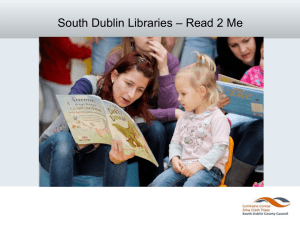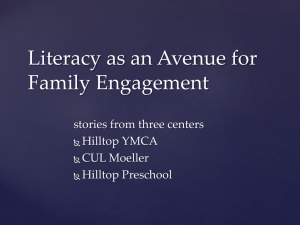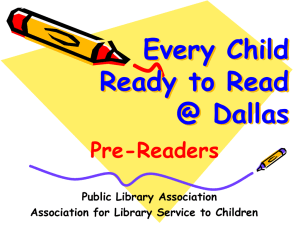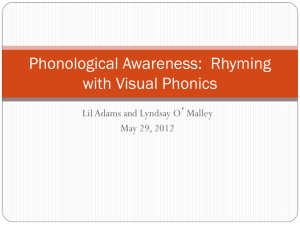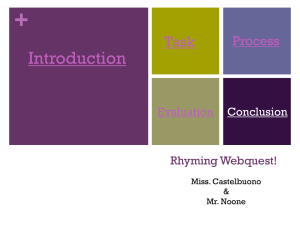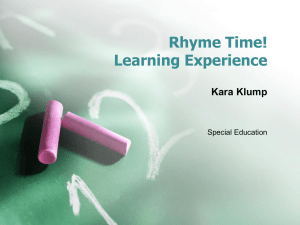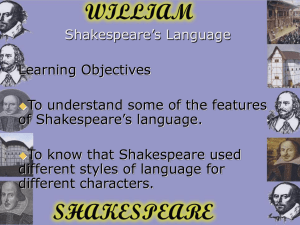From Rhyming to Reading
advertisement
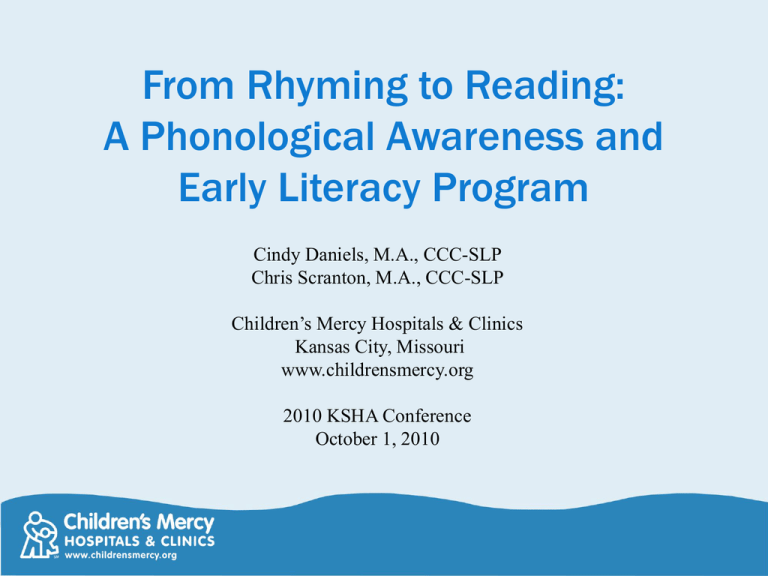
From Rhyming to Reading: A Phonological Awareness and Early Literacy Program Cindy Daniels, M.A., CCC-SLP Chris Scranton, M.A., CCC-SLP Children’s Mercy Hospitals & Clinics Kansas City, Missouri www.childrensmercy.org 2010 KSHA Conference October 1, 2010 Topics Role of speech-language pathologist in teaching literacy Literacy Research From Rhyming to Reading: A Phonological Awareness and Early Literacy Program Speech-Language Pathologists and Literacy: ASHA Position Statement 2001 The American Speech-Language-Hearing Association’s (ASHA) position statement on literacy states: Speech-Language Pathologists play a critical role in the development of literacy for children and adolescents with communication disorders. Literacy Facts and Speech-Language Pathologists Literacy Facts: Speech-Language Pathologists: Phonological awareness, reading and writing are language based functions. are language specialists. Difficulty learning to read or write can involve any of the components of language: phonology, morphology, syntax, semantics and pragmatics. understand the components of language: phonology, morphology, syntax, semantics and pragmatics. Children with language impairments are 4-5 times more likely than normally developing children to have reading difficulties. (Catts et al, 2002) have the opportunity to provide early identification and treatment. have experience in developing individualized treatment programs. Reading instruction needs to be explicit and systematic. SLP’s Role in Literacy (ASHA 2001) Prevention of reading disorders by fostering language acquisition and emergent literacy Identification of children at risk for literacy problems Assessment of reading and writing skills Providing Intervention for reading and writing Documenting Outcomes Other roles: provide assistance to general education teachers, parents and students; advocate for effective literacy practices; advancing the knowledge base Literacy Research National Reading Panel (1997) The best approach to reading instruction is one that incorporates systematic and explicit instruction in the areas of: Phonemic awareness Phonics Fluency Comprehension Vocabulary Literacy Research The International Dyslexia Association (IDA) supports the use of a multisensory approach to teaching children to read. Multisensory teaching: the use of visual, auditory, and kinesthetic-tactile pathways simultaneously to enhance memory and learning. From Rhyming to Reading: A Phonological Awareness and Early Literacy Program From Rhyming to Reading: began in 1999 and has taught over 1000 children was developed by speech-language pathologists is research and evidence based introduces five key components of reading: phonological awareness phonics fluency comprehension vocabulary uses a systematic, explicit multisensory approach From Rhyming to Reading Program Details Meets once a week for one hour Consists of 4-5 children with one speech-language pathologist Parent education with home activities provided Children 4 years of age and not yet in first grade Two Levels: – Level One: 10 weeks, focuses on rhyming, segmentation, initial sound recognition/production and letter sound correspondence – Level Two: 7 weeks focuses on alliteration, initial/final sound recognition/production, early decoding, syllable deletion and letter sound correspondence From Rhyming to Reading A Retrospective Research Study Purpose: Determine if From Rhyming to Reading is an effective program to teach phonological awareness skills to young children. Questions: Is From Rhyming to Reading an effective program to teach phonological awareness skills across subjects with varying speech, language, and learning history? Is From Rhyming to Reading an effective program to teach phonological awareness skills across specific age groups? Which phonological awareness skills taught in From Rhyming to Reading showed the greatest gains? From Rhyming to Reading A Retrospective Research Study Subjects: 342 male: 68% female: 32% Subject History: Ages: 4.0 to 4.11: 56% Articulation disorder Language disorder 5.0 to 6.11: 44% Family Hx Learning Problems Normal Development Retrospective Study: Between January 1, 2001 to August 31, 2007 History data collected by chart review and by caregiver report Outcome data collected from phonological awareness pre and post test scores Data analyzed based on subject history, age group, and subtest progress Is From Rhyming to Reading an effective program to teach phonological awareness skills across subjects with varying speech, language and learning history? From Rhyming to Reading was effective in teaching phonological awareness skills across all subject groups. Is From Rhyming to Reading an effective program to teach phonological awareness skills across specific age groups? From Rhyming to Reading was effective in teaching phonological awareness skills across age groups. Which phonological awareness skills taught in From Rhyming to Reading showed the greatest gains? Greatest gains in Level 1 in the areas of: Rhyme Production Letter Sound Correspondence Syllable Segmentation Statistically significant gains in all subtests Which phonological awareness skills taught in From Rhyming to Reading showed the greatest gains? Greatest gains in Level 2 in the areas of: Final Sound Production Letter Sound Correspondence Statistically significant gains in all subtests From Rhyming to Reading Summary of Retrospective Research Study From Rhyming to Reading: was effective in teaching phonological awareness skills across subject groups: typically developing children and children with reported history or family history of articulation, language, or learning deficits. was effective in teaching phonological awareness skills across age groups. was effective in teaching all targeted phonological awareness skills with the greatest gains in the areas of: rhyme production, letter sound correspondence, syllable segmentation and final sound production. was effective in teaching phonological awareness skills to young children with an average gain of 29 – 35% improvement in total test scores following two months of instruction including a home program. From Rhyming to Reading Weekly Session Format Opening: welcome, rules, review of homework Concept: phonological awareness skill Sound: letter sound correspondence, writing Movement: gross motor activity to reinforce weekly concepts and letter sound correspondence Closing: review of lesson, homework, prize, parent handout From Rhyming to Reading: Highlights Book Introduction Rhyming Segmentation Initial/Final sounds Alliteration Letter sound correspondence Writing Book Introduction Teach the parts of a book: Cover Title Author Illustrator Teach Language skills: Prior knowledge Prediction Vocabulary Rhyming Rhyming: words sound the same at the end. important to early literacy because it teaches the skill of isolating sounds in words. requires understanding of the concepts same and different and beginning and end. Rhyming Hands: A multisensory technique for teaching rhyming: “hold” the words in each hand (place palm up in front of body as you say each word.) If the words rhyme, clap hands together. If the words do not rhyme, don’t clap and shrug shoulders. Rhyming: Additional Information teach and practice rhyming by using real and nonsense words teach and practice rhyming by having children both detect and produce rhymes read familiar rhyming books and leave off the ending word in rhyming pair for the children to produce encourage families to play rhyming games in the car Segmentation: Sentences Sentence Segmentation: a sentence is the largest independent unit of grammar made up of individual parts called words important to early literacy because it increases a child’s print awareness make it multisensory by using hand motions while saying: “A sentence is a short story made up of small parts called words with a period on the end to tell us that the sentence is over.” components of a sentence Segmentation: Syllables Syllable Segmentation: a syllable is a word or part of a word that consists of an uninterrupted expression of sound and includes at least one vowel (Traub and Bloom, 2000) important to early literacy because syllable knowledge prepares children for decoding make it multisensory by using an activity such as clapping hands, pulling apart beads, or tapping beanbags to count syllables syllable deletion activities should also be included to teach that our language is made up of parts that can be manipulated Segmentation: Sounds Sound segmentation: words are made up of individual parts called sounds (phonemes) important to early literacy because the ability to identify individual sounds within words is strongly correlated to the acquisition of spelling, reading and writing (Gillingham and Stillman,1997) requires understanding of the concepts first (beginning), middle and last (ending) start by teaching children to identify beginning and ending sounds: use all senses (look, listen, and feel) when teaching early decoding skills, use a multisensory technique such as “Sound and Scoop” to identify individual sounds in a word and then to blend them together to form the word Alliteration the repetition of the same initial sound in words important to early literacy because it reinforces the ability to isolate individual sounds in words requires understanding of the concept of beginning/first may see difficulties in generating alliteration because it is a language (vocabulary) task Letter Sound Correspondence Letter sound correspondence is the foundation of phonics skills. Teach: concept of symbol/sound correspondence name of letter sound of letter placement, manner, and voicing name cue for letter hand motion voicing letter formation movement Writing writing is making a symbol for a sound on paper important to early literacy because it reinforces letter sound correspondence; introduces spelling; introduces perception of where letters are placed on the lines of the paper requires understanding of concepts top, middle, bottom, left and right when teaching letter writing use a multisensory technique such as the “Tree Writing Paper” From Rhyming to Reading Session Closing Review concept and sound of the week Explain homework Give prize to reinforce sound of week From Rhyming to Reading Interactive DVD On screen navigation through 16 lesson plans Each lesson contains video clips of systematic, explicit, multisensory techniques Material lists Printable materials: lesson plans, rule cards, sound cards, pictures, parent handouts Available in 2011 Questions? References American Speech Language Hearing Association (www.asha.org). Catts, H., Fey, M., Tomblin, B., & Zhang, X. (2002). A Longitudinal Investigation of Reading Outcomes in Children With Language Impairments. Journal of Speech and Hearing Research, 45, 1142-1157. Gillingham, A., Stillman, B. (1997). The Gillingham Manual: Remedial Training for Students with Specific Disability in Reading, Spelling, and Penmanship. Cambridge, MA: Educators Publishing Service, Inc. International Dyslexia Association (www.interdys.org). Mleziva, M., Trebach, D. (2000). Phonological Awareness: The Missing Piece to Help Crack the Reading Code. Eau Claire, WI: Otter Creek Institute. National Reading Panel. (2000). U.S. Department of Health and Human Services Public Health Service, National Institutes of Health, National Institute of Child Health and Human Development, NIH Pub. No. 00-4769. Shaywitz, S. (2003). Overcoming Dyslexia. New York: Alfred A. Knopf. Traub, N., Bloom, F. (2000). Recipe for Reading. Cambridge, MA: Educators Publishing Service, Inc.

